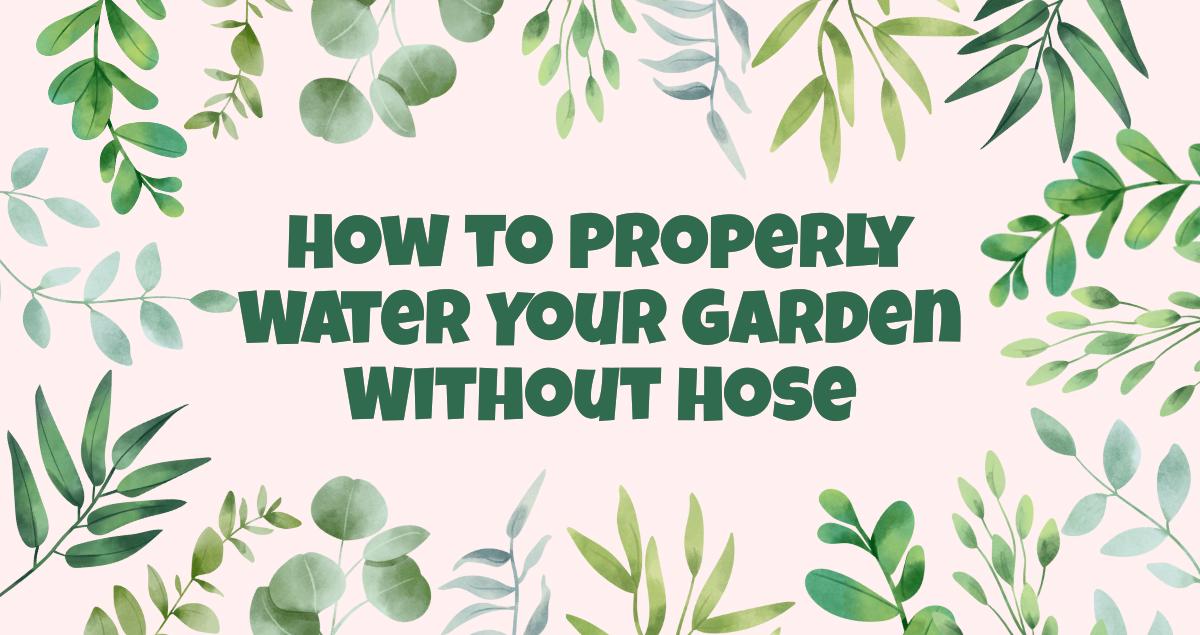Properly watering your garden is essential for maintaining healthy and thriving plants. Without sufficient water, plants can become stressed, wilt, and eventually die. Understanding the watering needs of different plants and using the right techniques can help ensure that your garden receives the proper amount of water it needs to flourish.
Table of Content
How to Properly Water Your Garden Without Hose
To properly water your garden without a hose, use alternative methods such as watering cans, drip irrigation systems, or soaker hoses. Ensure that you water deeply and infrequently, focusing on the root zone of the plants. Mulching the soil helps retain moisture, while watering in the early morning or late evening reduces evaporation. Regularly monitor soil moisture and adjust watering accordingly for healthy, thriving plants.
Importance of Properly Watering Your Garden
Water is a vital resource for plants as it helps transport nutrients, regulate temperature, and support photosynthesis. Proper watering is crucial for maintaining the overall health and vitality of your garden. When plants receive the right amount of water, they are better equipped to resist diseases, pests, and environmental stressors.
On the other hand, overwatering can lead to root rot, fungal diseases, and nutrient leaching. Underwatering, on the other hand, can cause plants to become dehydrated and unable to absorb nutrients effectively. Therefore, finding the right balance is key to ensuring your garden thrives.
Understanding the Watering Needs of Different Plants
Not all plants have the same watering requirements. Different factors such as plant type, stage of growth, and environmental conditions can influence how much water a plant needs. For example, vegetables and annual flowers generally require more water than established trees and shrubs.
It's important to research and understand the specific watering needs of the plants in your garden. Some plants prefer consistently moist soil, while others prefer a drier environment. By understanding these needs, you can tailor your watering practices accordingly.
Factors to Consider Before Watering
Before watering your garden, there are several factors you should consider to ensure efficient water usage and plant health. One important factor is soil type. Sandy soils drain water quickly, while clay soils retain water for longer periods. Understanding your soil type can help you determine the frequency and duration of watering.
Weather conditions also play a role in watering. During hot and dry periods, plants may require more frequent watering to compensate for increased evaporation. On the other hand, during cooler and wetter periods, you may need to adjust your watering schedule to avoid waterlogged soil.
Lastly, plant maturity is another important factor to consider. Newly planted seedlings and young plants require more frequent watering to establish their root systems. As plants mature, their root systems become more developed and can access water deeper in the soil. Adjusting your watering practices as plants grow can help promote healthy root growth.
Watering Techniques for Gardens without a Hose
Not everyone has access to a hose for watering their garden. However, there are alternative methods that can be just as effective.
Watering Methods for Gardens without a Hose
When it comes to watering your garden without a hose, there are several techniques you can use to ensure your plants receive the water they need.
Using Watering Cans
Watering cans are a versatile and efficient tool for watering plants. They allow for precise watering, allowing you to target the base of plants without wasting water on surrounding areas. When using a watering can, it's important to water slowly and evenly to ensure the water reaches the roots.
Watering cans are especially useful for container gardens or small areas where a hose may not be practical. They can also be used to apply liquid fertilizers or compost teas directly to the soil, providing additional nutrients to your plants.
Drip Irrigation Systems
Drip irrigation systems are a highly efficient method of watering your garden. These systems deliver water directly to the roots of plants through a network of tubes and emitters. Drip irrigation allows for precise control over water distribution, reducing water waste and promoting healthier root growth.
Drip irrigation systems can be set up to operate on timers, ensuring consistent watering even when you're not available. They are particularly beneficial for larger gardens or areas with water restrictions, as they minimize water usage while still providing plants with the necessary moisture.
Soaker Hoses
Soaker hoses are another effective option for watering your garden without a hose. These hoses are made of porous material that allows water to seep out slowly and evenly along their length. They can be placed directly at the base of plants or buried slightly under the soil surface.
Soaker hoses are particularly useful for watering large areas or garden beds. They provide a gentle and consistent water supply, ensuring that plants receive the necessary moisture without wasting water through evaporation or runoff.
Tips for Efficient Garden Watering
In addition to using the right watering techniques, there are several tips you can follow to ensure efficient watering and water conservation in your garden.
Watering in the Morning
Watering your garden in the morning is generally the best time of day. During this time, temperatures are cooler, and winds are usually calmer, reducing water loss through evaporation. Watering in the morning also allows plants to dry off during the day, reducing the risk of fungal diseases.
Watering at the Base of Plants
When watering your garden, it's important to focus the water at the base of plants. This helps ensure that the water reaches the roots where it is needed most. Avoid watering the foliage as this can increase the risk of diseases and wasteful water evaporation.
Monitoring Soil Moisture
Regularly monitoring the moisture levels of your soil is crucial for determining when to water. Stick your finger into the soil up to the first knuckle. If it feels dry at this depth, it's time to water. If it feels moist, you can wait a bit longer. This simple test can help prevent overwatering or underwatering your plants.
Conclusion
Properly watering your garden is essential for the health and vitality of your plants. By understanding the watering needs of different plants, considering factors such as soil type and weather conditions, and using the right watering techniques, you can ensure that your garden thrives. Remember to water in the morning, focus on the base of plants, and monitor soil moisture levels to conserve water and promote plant health. With these tips in mind, you can enjoy a beautiful and flourishing garden without the need for a hose.

